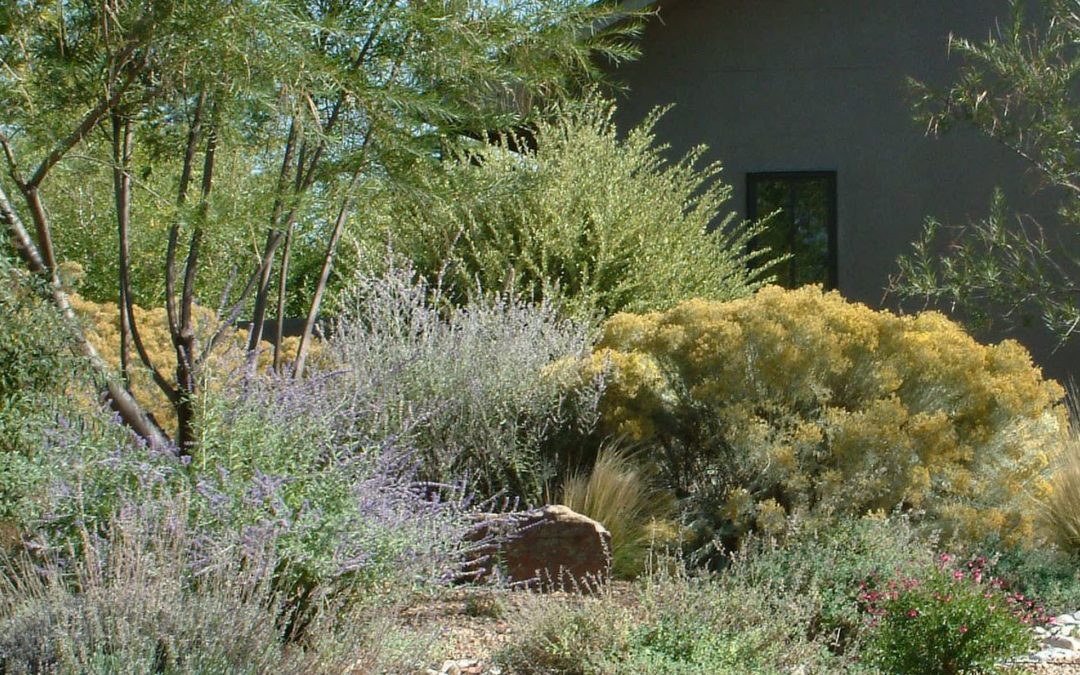In these long, hot days of summer, especially if the summer rains don’t come, many plants really suffer from a lack of water. By incorporating native and very adapted plants into the landscape, we can still have attractive landscapes that don’t require a lot of irrigation, maybe even none in a good year!
These native plants are sometimes referred to as “luxury consumers.” Their evolution, in an arid climate that occasionally has wetter years, has given them the ability to subsist reasonably well on low water. When there is an abundance of water, they take advantage of it and really grow. This kind of luxury growth may happen only every few years. In really dry years, they will lose some outer canopy. This adaptability helps them survive and even thrive in our natural landscape.
Among the plants that fit into this category are trees, shrubs, and native grasses: desert willow, Apache plume, three-leaf sumac, four-wing saltbush, chamisa, turpentine bush, and Mexican thread grass. There are others of a similar nature; native plants that really don’t need regular abundant water. Cactus is another type of plant that is easily over-watered. You might even end up killing it with too much water, as its roots rot away in constantly moist soil. If cacti don’t die, they may end up taking over a space.
One of the great aspects of xeric plants is that they are low maintenance. Small trees and shrubs live happily for years without needing pruning. Single stands of attractive, waving silky-looking grass seed heads don’t become a billowing menace when they quickly spread beyond the designed zone.
These plants should be irrigated regularly the year of planting but should be weaned to a lean water budget before they get too used to luxury living. A luxury level of irrigation should be saved for fruit trees and shade trees — plants that actually need that amount of water and produce fruit and shade.
To help save water, look for water harvesting opportunities in your landscape, especially when deciding where to plant. Where does water come off the roof, and where does it go on the ground? If you can redirect that roof water to a high spot that will flow into the yard — and maybe even contour the yard in shallow, subtle ways to get that water to spread out and slow down and sink in — then you can take advantage of the water by planting strategically along the flow line.
Mulches are a great water-saving step for native trees and shrubs. Rock is too hot for most things, except for ocotillo and some cacti, so use coarse chipped tree waste. Some local tree companies offer free mulch. Keep sunlight off bare ground around the plants and you will slow down evaporation from the soil while reducing the ambient air temperature enough to make a difference to the plants living out there all day, every day.
As far as shearing goes, this kind of pruning creates very tight outer canopies with lots of leaves (the resulting growth that follows previous cutting), usually in a simple geometric shape. Native plants that have less dense outer canopies end up having a higher water budget due to the excess foliage grown by shearing the canopy. A natural form could have the same overall size but with a more open, interesting branching framework supporting a more natural leaf density, and all of that on less water. It’s best to let the plant’s nature express itself through the form it grows without a lot of interference and to prune strategically to highlight well-placed branch systems and balanced mass.
Learn more by reading these articles:
Make this the year that you replace your thirsty lawn with a desert-friendly xeriscape.
WA Customers list the “Top Reasons to Convert a Lawn to a Desert-Friendly Xeriscape”
Desert Friendly Xeriscape Conversion Rebates


